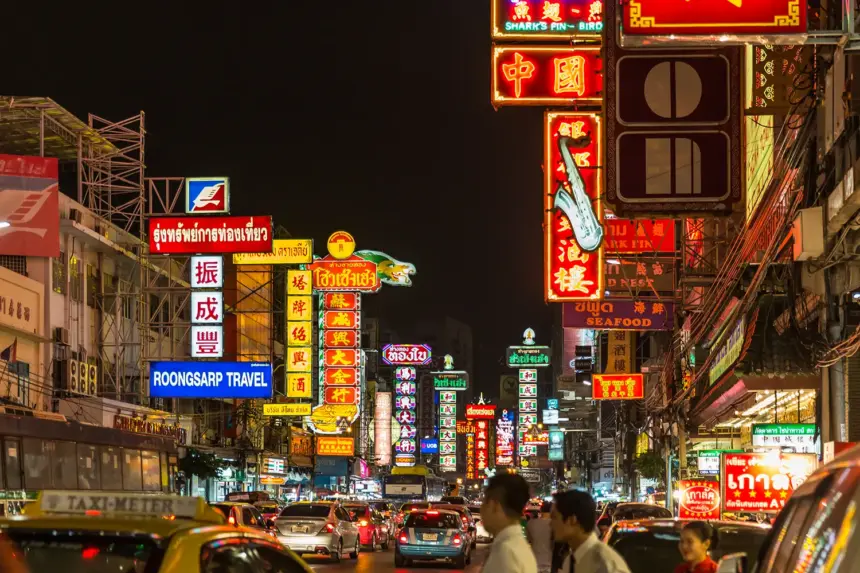Yaowarat Chinatown in Bangkok: A Complete Guide to Bangkok’s Vibrant Chinese Quarter
Yaowarat, better known as Bangkok’s Chinatown, is one of the city’s most vibrant and bustling neighborhoods. Renowned for its rich history, dazzling street food scene, and bustling night markets, Yaowarat draws locals and tourists alike to explore its unique blend of Chinese-Thai culture. From sampling delicious street foods to visiting historic temples and enjoying cultural festivals, there’s something for everyone in Yaowarat.
- Yaowarat Chinatown in Bangkok: A Complete Guide to Bangkok’s Vibrant Chinese Quarter
- History of Yaowarat Chinatown
- Top Attractions in Yaowarat Chinatown
- 1. Wat Mangkon Kamalawat (Dragon Lotus Temple)
- 2. Yaowarat Road Street Food Scene
- 3. Sampeng Lane Market
- 4. Chinatown Gate
- 5. Talat Kao Market
- Street Food Highlights: What to Eat in Yaowarat Chinatown
- 1. Kuay Jub (Rolled Noodle Soup)
- 2. Hoy Tod (Oyster Omelet)
- 3. Crispy Pork Belly
- 4. Chinese Buns (Salapao)
- 5. Thai-Chinese Desserts
- Shopping in Yaowarat Chinatown
- Gold Shops
- Traditional Chinese Medicine Shops
- Souvenirs and Accessories
- Tips for Visiting Yaowarat Chinatown
- Conclusion: Experience the Charm of Yaowarat Chinatown
In this article, we will explore everything you need to know about Yaowarat Chinatown in Bangkok: from its history and top attractions to food highlights, shopping tips, and visiting tips to make the most out of your trip.
History of Yaowarat Chinatown
Bangkok’s Chinatown, located on Yaowarat Road, dates back to 1782, the year when King Rama I established Bangkok as the capital of Thailand. Chinese merchants played a vital role in building trade connections, and soon after, Yaowarat became a thriving trade hub. Over centuries, this district has evolved while still preserving the traditional Chinese culture of its original settlers.
Today, Yaowarat reflects this rich history, blending traditional Chinese customs with the hustle and bustle of modern Bangkok, and is a testament to the enduring bond between the Chinese and Thai communities.
Top Attractions in Yaowarat Chinatown
1. Wat Mangkon Kamalawat (Dragon Lotus Temple)
The Wat Mangkon Kamalawat is one of Bangkok’s largest and most important Chinese-Buddhist temples. Originally known as Wat Leng Noei Yi, this temple offers a peaceful escape from the lively Chinatown streets and is especially popular during the Chinese New Year. With its intricate architecture, dragon statues, and colorful decorations, Wat Mangkon Kamalawat is a must-visit for those interested in Thai-Chinese culture.
2. Yaowarat Road Street Food Scene
Yaowarat is famous worldwide for its incredible street food. As the sun sets, food stalls open up along Yaowarat Road, transforming the area into a vibrant street food paradise. From traditional dim sum and roast duck to Thai-style noodles and mango sticky rice, there are countless delicacies to sample. Some popular dishes include Kuay Jub (rolled noodle soup), Hoy Tod (oyster omelet), and Chinese buns.
3. Sampeng Lane Market
The Sampeng Lane Market is a bustling, narrow alley filled with stalls selling everything from clothes and accessories to souvenirs and household items. This vibrant market is perfect for those who enjoy haggling and finding unique items. The market offers a more local experience and is a great spot for bargain shopping.
4. Chinatown Gate
Located at the entrance of Yaowarat Road, the Chinatown Gate is a landmark that symbolizes the friendship between Thailand and China. It’s also a popular photo spot, especially at night when it’s illuminated. Built to commemorate the 60th birthday of King Bhumibol Adulyadej, the gate welcomes visitors to Chinatown and marks the start of Yaowarat Road’s unique atmosphere.
5. Talat Kao Market
One of the oldest markets in Bangkok, Talat Kao is an indoor food market that offers an array of ingredients, herbs, teas, and traditional snacks. From dried seafood to Chinese medicinal herbs, Talat Kao Market showcases authentic Chinese culture in a traditional setting. It’s a great place to shop for unique ingredients, as well as to experience the sights and smells of a traditional Chinese market.
Street Food Highlights: What to Eat in Yaowarat Chinatown
Yaowarat is one of Bangkok’s most celebrated food destinations, and for a good reason. The sheer diversity of food options is unparalleled, and there’s something for every taste.
1. Kuay Jub (Rolled Noodle Soup)
A popular Chinese-style soup, Kuay Jub features rolled rice noodles in a flavorful, peppery broth, often served with crispy pork belly and other meats. This dish is perfect for those who enjoy hearty, savory flavors and is a must-try for anyone visiting Chinatown.
2. Hoy Tod (Oyster Omelet)
The oyster omelet is another popular street food in Yaowarat. Made with fresh oysters, eggs, and starch, the omelet is fried to a crispy, golden perfection and served with a tangy chili sauce. Its unique texture and flavor make it a local favorite.
3. Crispy Pork Belly
You’ll find crispy pork belly in many stalls along Yaowarat Road. This dish offers a delightful mix of crispy and tender textures, making it a satisfying choice for meat lovers. Paired with rice or as part of a noodle dish, it’s a delicious treat to try.
4. Chinese Buns (Salapao)
These steamed buns are filled with a variety of fillings, including pork, custard, and red bean paste. Salapao is easy to eat on the go, making it a popular snack for those exploring Yaowarat’s busy streets.
5. Thai-Chinese Desserts
End your street food adventure with something sweet. Try the mango sticky rice, sesame dumplings, or freshly made coconut ice cream. Many dessert stalls offer a mix of Thai and Chinese flavors, providing a unique experience for your taste buds.
Shopping in Yaowarat Chinatown
Yaowarat is not only about food; it’s also a fantastic place for shopping. From gold shops to quirky stores selling traditional Chinese medicine, Yaowarat has it all.
Gold Shops
Yaowarat is known for its gold shops that line the main street, offering high-quality gold jewelry at competitive prices. Many of these shops have been around for generations, and they’re a part of Yaowarat’s identity.
Traditional Chinese Medicine Shops
If you’re interested in herbal remedies, you’ll find several shops offering traditional Chinese medicine along Yaowarat Road. These stores sell everything from herbal teas to natural remedies, each with their unique benefits.
Souvenirs and Accessories
Sampeng Lane Market is a go-to destination for souvenirs, accessories, and traditional Chinese items. You can find everything from small trinkets to clothing, making it a great place to pick up souvenirs for friends and family.
Events and Festivals in Yaowarat Chinatown
Yaowarat truly comes alive during festivals, and two major events stand out:
Chinese New Year
During Chinese New Year, Yaowarat is adorned with red lanterns, dragon decorations, and lights. The celebration includes parades, dragon dances, and a variety of performances that highlight Chinese culture. It’s the most popular time to visit Chinatown and experience its festive atmosphere.
Vegetarian Festival
The Vegetarian Festival, held every October, is another vibrant event in Chinatown. During this festival, many vendors switch to vegetarian menus, serving a variety of plant-based dishes. It’s a fantastic time for foodies to explore new flavors and enjoy a different side of Chinatown.
Tips for Visiting Yaowarat Chinatown
1. Visit in the Evening: The best time to explore Yaowarat is in the evening when the street food stalls open up, and the area transforms into a lively night market.
2. Wear Comfortable Clothing and Shoes: Yaowarat can get crowded, especially during peak hours. Comfortable shoes and breathable clothing will make your visit much more enjoyable.
3. Stay Hydrated: Bangkok’s weather can be hot and humid, so make sure to carry a water bottle, especially if you’re planning to explore on foot.
4. Be Ready to Bargain: If you’re shopping at Sampeng Lane Market, bargaining is common and expected. Don’t hesitate to negotiate prices with the vendors.
5. Mind Your Belongings: With the bustling crowd, it’s essential to keep an eye on your belongings, especially around busy areas and markets.
Conclusion: Experience the Charm of Yaowarat Chinatown
Yaowarat Chinatown in Bangkok is a destination like no other, offering a unique blend of Thai and Chinese culture, unforgettable street food, and a lively shopping scene. From exploring historical temples to tasting a wide variety of street food, there’s something for everyone in this vibrant district. Whether you’re a foodie, history enthusiast, or simply looking to immerse yourself in Bangkok’s local culture, Yaowarat has an experience waiting for you.
Plan a visit to Yaowarat Chinatown and discover why it’s one of Bangkok’s most beloved neighborhoods.










